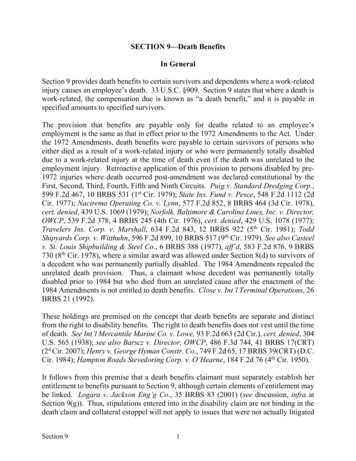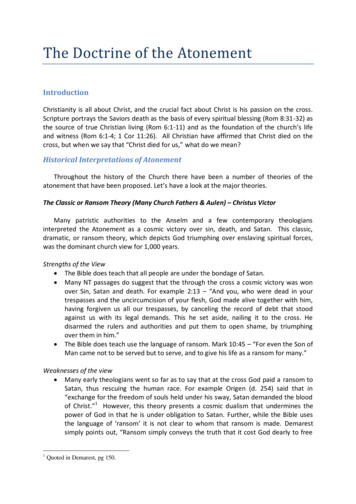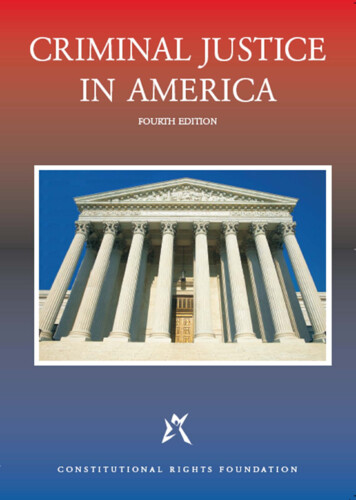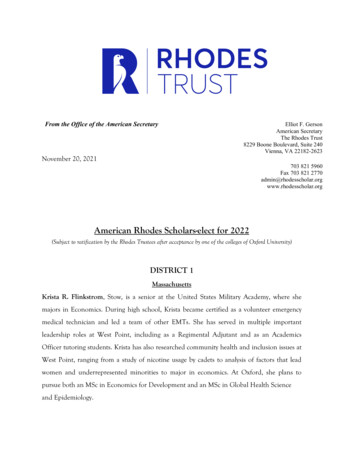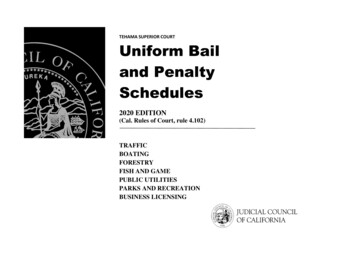
Transcription
THE DEATH PENALTY THROUGH THE LENSES OFCRIMINOLOGY/CRIMINAL JUSTICESTUDENTS AND NON-CRCJSTUDENTSbySHIRLEY A. HAMBLETPresented to the Faculty of the Graduate School ofThe University of Texas at Arlington in Partial Fulfillmentof the Requirementsfor the Degree ofMASTER OF ARTS IN CRIMINOLOGY AND CRIMINAL JUSTICETHE UNIVERSITY OF TEXAS AT ARLINGTONDecember 2006
Copyright by Shirley A. Hamblet 2006All Rights Reserved
ACKNOWLEDGEMENTSI would like to first extend my gratitude and thanks to Dr. Alejandro delCarmen. His enthusiastic approach to the subject of Criminology/Criminal Justice hasbeen an inspiration to me and has made the completion of this thesis possible. Inaddition, I would like to thank Dr. John W. Stickels and Dr. Rodrigo Paris for theirgenerous time and support.The realization of this accomplishment could never have been possible withoutthe assistance of two very special people. The love and support of my husband, David,was absolutely essential. He not only encouraged me, but made many sacrifices so thatI could focus my time and energy to the completion of this thesis. My daughter Brandyhas always believed in her “Mom”. Her words of support and encouragement havemeant the world to me. Finally, I would like to acknowledge the countless otherfriends, classmates and family members who have believed in me. Thisaccomplishment is shared with all of you.October 11, 2006iii
ABSTRACTTHE DEATH PENALTY THROUGH THE LENSES OFCRIMINOLOGY/CRIMINAL JUSTICESTUDENTS AND NON-CRCJSTUDENTSPublication No.Shirley A. Hamblet, M.A.The University of Texas at Arlington, 2006Supervising Professor: Alejandro del CarmenThe purpose of this study is to examine the possible relationship between levelof knowledge and perception regarding capital punishment among criminology/criminaljustice (CRCJ) students in comparison with non-CRCJ majors. The data for this studywere obtained from a sample of CRCJ and non-CRCJ majors enrolled at the Universityof Texas at Arlington. While CRCJ majors appeared to be more knowledgeableregarding capital punishment, there was little significant difference of opinion(perception) among CRCJ and non-CRCJ majors.iv
TABLE OF CONTENTSACKNOWLEDGEMENTS.iiiABSTRACT .ivLIST OF TABLES.xLIST OF CASES .xiChapter1. INTRODUCTION .11.1 History of the Death Penalty.31.2 Deterrence Theory .111.3 The Present Study .132. LITERATURE REVIEW .172.1 The History of Capital Punishment .182.1.1 Early Death Penalty Laws .182.1.2 Executions throughout the Middle Ages .202.1.3 Executions in England .222.1.4 Opposition to Capital Punishment .242.2 Capital Punishment in the United States .252.2.1 Beccaria’s Influence in the United States .272.2.2 Capital Punishment during the Civil War:North and South .30v
2.2.3 Race and Capital Punishment .312.2.3.1 Rape, Race and Capital Punishment .332.2.4 Capital Punishment in the Twentieth Century.342.2.5 The Supreme Court and Capital Punishment.372.2.5.1 Abolition and Reinstatement: The Furmanand Gregg decisions .372.2.5.2 Capital Punishment, Insanity andMental Retardation .382.2.5.3 Age and Capital Punishment.382.2.5.4 Race and the Death Penalty.392.2.6 Public Executions .392.2.6.1 The Debate over televising executions .412.2.7 Capital Punishment in the Twenty-first Century .422.3 American Death Penalty Knowledge .432.3.1 The Marshall Hypothesis.432.3.2 The American Public and Testingthe Marshall Hypothesis.442.3.3 Public Support .462.3.4 Public Opinion and the Willingnessto Pass Judgment .502.3.5 Death Penalty Opinion and Race.522.3.6 Death Penalty Knowledge and College Students .572.3.6.1 The Later Nineteenth Century Knowledge/Perceptions .57vi
2.3.6.2 Twenty-first Century Knowledge and Opinions .622.3.7 Studies Addressing Knowledge and Perceptionamong Criminology/Criminal Justice Majors.642.3.7.1 The nineteen-eighties .642.3.7.2 The nineteen-nineties .652.3.7.3 The twenty-first Century .673. METHODOLOGY AND DESIGN.703.1 Construction of the Survey Instrument.713.1.1 IRB Review and Approval.733.2 Sampling Method.733.3 Data Collection .753.3.1 Survey Instrument.753.4 Statistical Manipulation .774. FINDINGS.794.1 Demographics .804.2 CRCJ Responses and non-CRCJ Responses .824.2.1 Knowledge Items .824.2.2 Perception/Opinion Items .834.2.3 Information Source(s).864.2.3.1 Print Sources .864.2.3.2 Television, Radio and Electronic Media.864.2.3.3 Interactions with Others .874.3 Majority Responses and Minority Responses.88vii
4.3.1 Knowledge Items .884.3.2 Perception/Opinion Items .904.3.3 Information Source(s).924.3.3.1 Print Sources .934.3.3.2 Television, Radio and Electronic Media.934.3.3.3 Interactions with Others .935. DISCUSSION.955.1 Contribution to the Body of Knowledge .965.2 Limitations of the Research .965.3 Criminology/Criminal Justice Majorsand non-CRCJ Majors.975.3.1 Knowledge.975.3.2 Cultural/Social: Perception and CapitalPunishment.985.4 Majority and Minority Students.985.4.1 Knowledge.985.4.2 Cultural/Social: Perception and CapitalPunishment.995.5 Implications for education about capital punishment . 1005.6 Social/Cultural Implications . 1015.7 Suggestions for further research . 103AppendixA. PROFESSOR’S STATEMENT OF PURPOSE. 104B. INSTRUCTIONS FOR COMPLETION OF THE SURVEY . 106viii
C. STUDENT SURVEY . 108REFERENCES . 113BIOGRAPHICAL INFORMATION. 125ix
LIST OF TABLESTablePage1Spring 2006 Courses in Which Surveys Were Distributed . 742Demographics of Survey Respondents . 813Knowledge Based Differences among CRCJ and non-CRCJMajors. 834Perception/Opinion Differences among CRCJ and non-CRCJMajors. 855Information Source Differences among CRCJ and non-CRCJMajors in Percentages . 886Knowledge Based Differences among Majority andMinority Students. 897Perception/Opinion Differences among Majority andMinority Students. 928Information Source Differences among Majority andMinority Students in Percentages. 94x
LIST OF CASESPage1Atkins v. Virginia, 536 U.S. 304 (2002) . 382Batson v. Kentucky, 476 U.S. 79 (1986) . 393Coker v. Georgia, 433 U.S. 584 (1977) . 374Ford v. Wainwright, 477 U.S. 399 (1986) . 385Furman v. Georgia, 408 U.S. 238 (1972). 376Gregg v. Georgia, 428 U.S. 153 (1976) . 377Jurek v. Texas, 428 U.S. 262 (1976). 378McCleskey v. Kemp, 481 U.S. 279 (1987) . 399Penry v. Lynaugh, 492 U.S. 302 (1989). 3810Proffitt v. Florida, 428 U.S. 242 (1976) . 3711Roberts v. Louisiana, 428 U.S. 325 (1976). 3812Roper v. Simmons, 543 U.S. 551 (2005) . 3813Stanford v. Kentucky, 492 U.S. 361 (1989). 3814Thompson v. Oklahoma, 487 U.S. 815 (1988) . 3815Trop v. Dulles, 356 U.S. 86 (1958). 3716Witherspoon v. Illinois, 391 U.S. 510 (1968) . 37xi
CHAPTER 1INTRODUCTIONThe Eighth Amendment to the United States Constitution says “Excessive bailshall not be required, nor excessive fines imposed” and most importantly “nor cruel andunusual punishments inflicted”. Whether one believes the death penalty to be cruel andunusual or a just sentence in the face of an egregious crime, many Americans supportthe death penalty without knowing or caring much about the way in which it is carriedout (Bedau, 1997; Furman v. Georgia, 1972; Walker, Spohn & Delone, 2000). SupremeCourt Chief Justice William Brennan observed,It is tempting to pretend that [those] on death row share a fate in noway connected to our own, that our treatment of them sounds noechoes beyond the chambers in which they die. Such an illusion isultimately corrosive, for the reverberations of injustice are not soeasily confined the way in which we choose those who will diereveals the depth of moral commitment among the living (Bedau,1997, p. 299).Chief Justice Brennan’s observation has not been lost on those who have beenwrongly condemned to die. Randall Dale Adams served twelve years on Texas’ deathrow before being exonerated (Adams, 1991). His death at the hands of the State ofTexas would have taken place in a bleak room, strapped down to a gurney, with nochance left for exoneration. In 1996, DNA testing proved that not one of the so called“Ford Heights Four” was responsible for the rape and murder of a Chicago woman andher companion. Since then, more than 75 cases of persons wrongfully convicted have1
surfaced (McCormick, 1998). Still other capital murder defendants must contend withattorneys who spend little time preparing for trial, sleeping lawyers and courts thatrefuse to acknowledge the ineffectiveness of counsel claims that follow (Shapiro, 1997).Further, the death penalty has become a popular position for politicians who do notwish to appear soft on crime (Cockburn, 2001). Capital punishment is the most severesentence that can be given and one that is impossible for society to correct onceadministered. No apology, or compensation of money can give the person back his lifeor comfort his family. Therefore, the level of knowledge that future policy-makers haveabout the death penalty and how that shapes their perceptions and actions is of vitalimportance to every American, for one can never be certain that the mistake of justicewill not befall them.The question that begs to be answered is whether or not support for the deathpenalty has any correlation with knowledge about the death penalty, and if CRCJ andnon-CRCJ students differ in knowledge and support for capital punishment. SupremeCourt Justice Thurgood Marshall, stated in Furman v. Georgia (1972) that Americansknow little about capital punishment. He believed that if the average citizen knew thefacts, almost no-one would support the use of capital punishment. However, he furtherhypothesized that if one supported the death penalty for retributive reasons, no amountof knowledge would change their opinion (Furman v. Georgia, 1972; Walker, et al.,2000).Given the gravity of the death penalty and its political nature, it is imperativethat knowledge and perceptions among students who will become tomorrow’s policy2
makers and leaders within Texas’ criminal justice system, be examined in relation tostudents who major in other disciplines. The purpose of this study is to examine thepossible relationship between level of knowledge and perception regarding capitalpunishment among criminology and criminal justice (CRCJ) students in comparisonwith non-CRCJ majors. First, the study will attempt to determine whether there is adifference in level of knowledge of the death penalty among CRCJ majors and nonCRCJ majors. Second, the study will attempt to determine whether knowledge has anycorrelation with perception and opinion regarding the death penalty. The data for thisstudy were obtained from CRCJ and non-CRCJ undergraduate and graduate studentsattending the University of Texas at Arlington during the spring semester of 2006.1.1 History of the Death PenaltyCapital punishment has roots that extend as far back as Biblical times whenexecutions served the ends of God. People lived in fear of provoking God and believedthat his wrath would release upon them any number of natural disasters (Johnson,1998). In ancient Babylon, Hammurabi’s Code mandated the death penalty for 25crimes including sorcery and making false accusations of murder. Many of the laws ofthis time were based on retaliation or lex talionis (Lifton & Mitchell, 2002).In ancient Greece, death was the prescribed penalty for almost every violation oflaw imaginable. One could find himself executed for simply being idle or having stolensalt (Lifton & Mitchell, 2002). The earliest form of community punishment in Greecewas stoning. However, stoning was only used to punish those crimes that affected thecommunity (Johnson, 1998). The laws of Greece were so harsh that eventually public3
sentiment forced the abolition of the death penalty for most crimes (Lifton & Mitchell,2002).During the middle ages, executions were public and attended by the masses.Clergy often blessed the execution and the means of execution were varied. The upperclass could expect to be beheaded, while the lower class were left to suffer by hanging,drawing and quartering, drowning, being disemboweled (Johnson, 1998; Lifton &Mitchell, 2002) or breaking on the wheel, a process of hanging the victim by his feetand an executioner sawing his body in half vertically while still alive and conscious(Johnson, 1998).England’s bloody code was the harshest and most punitive in Europe ( Banner,2002). During the period 1714-1830, English Parliament had created 156 new capitaloffenses (Tonry, 1996). Most of these new offenses were property crimes (Dike, 1981;Tonry, 1996) that targeted the poor (Dike, 1981). By 1819 over 200 crimes weredesignated capital offenses (Banner, 2002; del Carmen, 2000; Dike, 1981; Tonry,1996). Although the bloody codes prevented torture such as the wheel, it implementedthe death penalty for crimes such as cutting down trees in parks (del Carmen, 2000),theft of turnips, lead, iron bars and gates (Dike, 1981), poaching deer and theft of smallsums of money (Banner, 2002). The English practice of leaving rotting corpses forothers to see is thought to have been done in an attempt to deter others from crime (delCarmen, 2000; Dike, 1981) but eventually the death penalty in England began to waneas juries refused to convict (Dike, 1981; Tonry, 1996), the accused began to claimbenefit of clergy, and many of those sentenced to death were never executed (Tonry,4
1996). In fact, executions in the late eighteenth century varied from between 21 peryear to 53 during the 1790s (Tonry, 1996). By 1829, capital crimes had declined to just15, and by 1861, just 4 crimes were considered capital offenses (Dike, 1981).Capital punishment in America was based on English law and was brought toAmerica during the seventeenth century by the first American colonists (Bedau, 1997).The first known execution in America occurred in 1622 in Virginia when Daniel Frankwas executed for theft (del Carmen, 2002). The earliest death penalty statutes recordedare from the Massachusetts Bay colony in 1636. Some of the original crimes for whichone could be executed included witchcraft, idolatry, and blasphemy (Dike, 1981). TheMassachusetts Code of 1648 provided capital punishments for crimes such as sodomy,man stealing, treason and homicide committed with malice (del Carmen, 2002) andeach offense was justified by use of Biblical quotation (Lifton & Mitchell, 2002).Between 1642 and 1650, a person in the New Haven Colony denying the existence ofGod could receive the death penalty (Inciardi, 1999) while in early Pennsylvania onlymurder and treason were punished by death (Lifton & Mitchell, 2002). During thisperiod death by hanging was the preferred method of execution (Bedau, 1997) and eachcolony’s laws differed from the next (Lifton & Mitchell, 2002).The abolition movement began in the 1700s when Cesare Beccaria, an Italianmathematician, wrote Des delitti e delles pene (On Crimes and Punishments) (Bedau,1997; del Carmen, 2002). Beccaria was born in Milan Italy in 1738 to an aristocraticfamily, and attended the University of Pavia where he received his degree in 1758 (delCarmen, 2002). Beccaria advocated penile servitude in place of the death penalty5
(Bedau, 1997, del Carmen, 2002) and believed that not only was the death penalty not aright of the state, but that it could only be considered necessary for only two reasons;that the safety of the nation continued to be in danger should the offender live, if theoffender was in a position by his very existence to provoke a revolution, or if his deathwould deter others from crime (Beccaria, 1996).Another early abolitionist was Benjamin Rush, an American who lecturedagainst public execution (Bedau, 1997) and was the first to present reasoned argumentswhy capital punishment should be abolished (del Carmen, 2002). In addition, Rushquestioned whether the Bible really provided support for capital punishment. Rush wasone of the first to suggest that capital punishment might not have a deterrent effect, butinstead have a brutalizing effect (Bohm, 2003).In Pennsylvania in 1793, the Quakers pushed for reform insisting that murder bedivided by two degrees; first and second degree murder (Bedau, 1997). In 1794,Pennsylvania did adopt degrees of murder, but first degree murder still carried amandatory death sentence (Dike, 1981; Lifton & Mitchell, 2002). Most states followedPennsylvania’s lead and adopted the concept of degrees of murder (Bedau, 1997; Bohm,2003), but the Quakers’ ultimate goal was to abolish the death penalty completely(Bedau, 1997; Dike, 1981). As the eighteenth century came to an end at least 1500persons had been executed in America (Lifton & Mitchell, 2002).In the nineteenth century, the use of the death penalty flourished. The use ofcapital punishment increased by 60% over the entire 17th and 18th centuries combined,although during the Civil War, usage dropped by two-thirds (Bohm, 2003). It was not6
until 1835 that New York outlawed public executions, moving the process indoors andaway from the public eye (Bedau, 1997, Bohm, 2003). Other states would soon follow,with the last public execution held in 1937 in Galene, Missouri (Bohm, 2003).In 1846, the state of Michigan abolished the death penalty for all crimes (Bedau,1997; Bohm, 2003; Dike, 1981) and during this period, the death penalty waseliminated in most European countries (del Carmen, 2002). In addition, Tennessee wasthe first state to implement a discretionary death penalty statute for murder in 1838, butmore than a full century would pass before, in 1963, all states would eliminatemandatory death penalties. In 1852 Rhode Island would repeal the death penalty,followed by Wisconsin in 1853 (Bedau, 1997; Bohm, 2003). Abolition in Ohio andPennsylvania would quickly follow, although many of these states would later reinstatethe death penalty (Bedau, 1997).The first state-imposed execution would not take place until the Civil War(Bohm, 2003; Dike, 1981). Nevertheless, in 1890 over 90 percent of executions werestill carried out under local authority (Bohm, 2003). Hanging was the first lawfulmeans of execution (Bohm, 2003) and would remain so for the first 100 years (Dike,1981). The electric chair was invented in New York in 1888 (Bedau, 1997), but wasnot used until two years later in 1890 (Dike, 1981). This method was followed by firingsquad, lethal gas, and finally, the method preferred today – lethal injection (Bohm,2003). Lethal injection was first adopted in Oklahoma in 1977 (Bohm, 2003) and firstused in Texas in 1982 (Bedau, 1997). Although hanging had outlived its popularity, thelast hanging in the United States did not take place until 1996 in Delaware (Bedau,7
1997) and the firing squad is still used in three states (Bohm, 2003). As late as 2001electrocution was declared unconstitutional by the Georgia Supreme Court and lethalinjection has become the preferred method of execution in all states except Nevada(Bohm, 2003; Death Penalty Information Center, 2006).The twentieth century began with the repeal of capital punishment in 9 states.Although it was believed at the time that all the other states would soon follow, thisnever happened. By the 1920s many of the states that had repealed the death penaltyreinstated it (Bedau, 1997). In the South and in some states in the West and Midwest,over 3,000 men and a few women, mostly black, were subjected to illegal executionscalled “lynchings”. Despite the fact that lynching was a capital crime itself, the mostlywhite mobs were not deterred. Jesse Jackson would comment “So much for deterrence”(Lifton & Mitchell, 2002, p. 37).In no time period in America was the death penalty practiced more than duringthe great depression when executions reached their highest levels of the entire twentiethcentury (Bedau, 1997). According to Bohm (2003), despite a growing demand forabolition, in 1935, 199 persons were executed and an average of 167 persons per yearwas executed during the nineteen-thirties.In the 1950s executions began to decline, partly because after World War II,many allied nations abolished the death penalty (Bohm, 2003). Two cases in the 1950sgalvanized the debate about the death penalty, but not in the same way. A pollconducted after the executions of accused cold war spies Julius and Ethel Rosenbergfound that over 70 percent of Americans supported the death penalty. This was the8
highest level of support ever attained for capital punishment (Bohm, 2003; Lifton &Mitchell, 2002). Caryl Chessman’s case was an entirely different matter. CarylChessman was convicted in 1948 on 17 counts including kidnapping and attemptedrape. What the American people saw was the lack of efficiency and purpose when after12 years of legal battles, Caryl Chessman was finally executed. Support for the deathpenalty began to wane (Bohm, 2003; Lifton & Mitchell, 2002).The level of support for the death penalty dropped in 1966 to only 42 percent –the lowest level of support ever recorded (Bedau, 1997, Bohm, 2003, Dike, 1981) andin 1968 executions ceased as the death penalty was being challenged in the UnitedStates Supreme Court. In 1972, Furman v. Georgia came before the Supreme Court.The court found that the death penalty had been applied in “an arbitrary and capriciousmanner” and therefore its application was unconstitutional. The death penalty itself wasnot found to be unconstitutional, but the court felt that there were no legislatedstandards and that juries could apply the death penalty to any murder case regardless ofcircumstances. They also felt that the death penalty violated the rights of minoritieswho were sentenced to death more often than whites (Furman v. Georgia, 1972). Thiseffectively commuted 629 sentences of death in 40 jurisdictions (Michigan StateUniversity 2006). The moratorium on the death penalty would not be lifted until Greggv. Georgia (1976) in which the Supreme Court reaffirmed the constitutionality of thedeath penalty (Bedau, 1997). Reforms included bifurcated trials in which guilt andpunishment were assessed separately, automatic appellate review, sentencing guidelinesand proportionality review (Michigan State University, 2001).9
Gary Gilmore became the first person to be executed after the ruling in Gregg v.Georgia (1976) and the first since 1967. In 1977 Gary Gilmore died by firing squad inUtah (Sheldon, 2001). In 1982, Charles Brooks, Jr. was executed in the State of Texasand became the first to die from a lethal mixture of sodium thiopental, pavulon andpotassium chloride. This method would become known as lethal injection and is themost widely used today (Lifton & Mitchell, 2002). Currently, 38 states retain the deathpenalty as do the federal government and United States military. Since the ruling ofGregg v. Georgia (1976), 1014 persons have been executed. In 2005, 60 people wereexecuted in the United States and as of September 9, 2006, 41 persons have beenexecuted, 20 in Texas alone. Currently, there are 3,370 people waiting on death row,with almost one-third of those in just two states - California (652) and Texas (404).There have been 123 death row exonerations since 1973 (Death Penalty InformationCenter, 2006).Debate about the death penalty continues into the twenty-first century. InJanuary of 2000, Governor Ryan of Illinois placed a moratorium on executions in thestate of Illinois after discovering that the state had executed 12 people, but exoneratedand released 13 people who had been condemned to die. As his last act of office,Governor Ryan generated an outpouring of controversy when he granted clemency tothe remaining 156 Illinois death row inmates (Death Penalty Information Center, 2006).His actions ignited anger in victim’s right proponents and elation for persons whooppose the death penalty (Death Penalty Informat
punishment among criminology and criminal justice (CRCJ) students in comparison with non -CRCJ majors. First, the study will attempt to determine whether there is a difference in level of knowledge of the death penalty among CRCJ majors and non - CRCJ majors. Second, the study will attempt to determine whether knowledge has any





